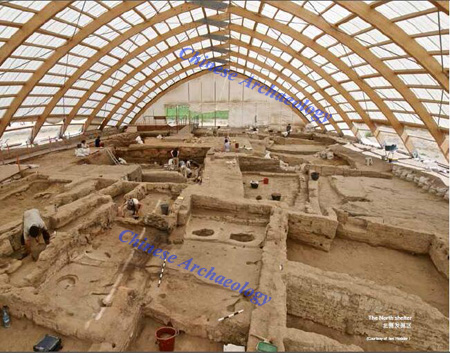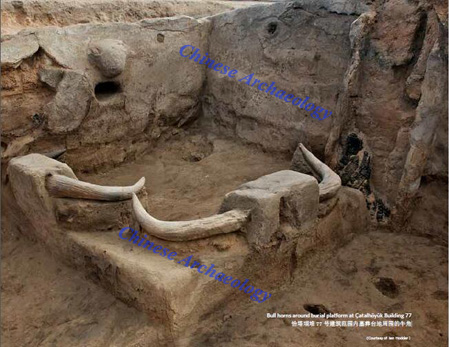Important Anatolian Contributions to the Development of Early Societies
From:Chinese Archaeology NetWriter:Ian HodderDate:2015-12-24
Catalhoyuk is an example of the important Anatolian contribution to the development of early societies. A site of this importance for Turkish and global heritage needs careful conservation and presentation to the public. It poses problems of conservation of mud brick and wall plaster, and problems of site management which have a wider applicability to many sites in the Eastern Mediterranean.Excavated by James Mellaart in the early 1960s, the site has been widely recognised as of unique international significance. The popular Collins guide to Turkey is one of many that describe Catalhoyuk as 'probably the most important archaeological site in Turkey'. It is one of the first mega-sites of early settlement and it has elaborate wall paintings and mural art. The spectacular art provides a direct window into life 9000 years ago, and the site is an internationally important key for our understanding of the origins of agriculture and settled life.

The North shelter
The ultimate aim is to provide the Turkish Ministry of Culture and Tourism with a well- planned heritage site (for the Site Management Plan see www.catalhoyuk.com). Visitors are able to experience the site in a number of ways. A conservation laboratory has been built and the latest techniques applied. The aim is that the conserved wall paintings, sculptures, textiles, wooden and ceramic artifacts will be placed on display in Konya Museum, enhanced by virtual reality techniques and interactive video. Part of the site is being covered so that the ancient houses are protected and so that visitors can walk around a Neolithic village. An experimental house has been built for tourist entry. By providing a range of visitor experiences the full heritage potential of the site can begin to be exploited.
The main research direction is to place the paintings and symbolism within a full environmental, economic and social context. Central questions concern the origins of the site and its early development, social and economic organisation and variation within the community, the reasons for the adoption of domestic cattle and the intensification of agriculture and sheep herding, the social context for the early use of pottery, temporal trends in the life of the community, and trade and relations with other sites in the region.
Catalhoyuk is dated to 7100-5500 BCE near Konya in central Turkey. There are two mounds but the main East Mound is 32 acres in size and 21m in height with 18 levels of occupation. For most of the time, the East Mound site held 3500-8000 people living in houses crammed together so that there were no streets and house entry was through the roof. Inside the houses there are remarkable paintings with narrative content, showing bulls and other animals being hunted and teased by people wearing leopard skins, and showing vultures taking the flesh from headless corpses. There are relief sculptures of leopards and bears. There are bucrania and bullhorns set on pillars. The character of the settlement changed considerably in the second half of the seventh millennium BCE. Multi-roomed houses devoid of elaborated symbolism became predominant. They had a large main room surrounded by multiple smaller rooms and street-level exterior entrances.
Prior to the excavations at Catalhoyuk in the early 1960s, there was little evidence to suggest an early development of the first farmers and the first towns and villages outside the Fertile Crescent. For this reason, the British archaeologist James Mellaart’s discoveries at Catalhoyuk inspired widespread interest. Initially the importance of the site was recognized as its large size at an early date and its location outside the supposed ‘cradle’ of civilization in the Near East. A major factor for its prominence was also undoubtedly its art, described by Sir Mortimer Wheeler as a ‘curious and sometimes a trifle macabre artistry’ which nevertheless distinguishes a site which ‘represents an outstanding accomplishment in the upward grade of social development’.
Today we know that Catalhoyuk was not the earliest or the largest farming community in Anatolia and the Levant; however, it was a major participant in the cultural and economic changes thatswept across the Near East in the Neolithic Period. Its strategic location in Anatolia made it a bridgehead for the spread of the Neolithic way of life to Europe and beyond. The Neolithic Site of Catalhoyuk stands out because of its large size, the length of its occupation (over 1,500 years), its dense concentration of ‘art’ in the form of wall paintings, wall reliefs, sculptures and installations, and its excellent state of preservation. Catalhoyuk is a site of great importance for our understanding of the first steps toward ‘civilization’, including early settled agricultural life and the overall process that led from settled villages to urban agglomerations.

Bull horns around burial platform at Çatalhöyük Building 77
In recognition of its significance, the site was in 2012 inscribed on the UNESCO World Heritage list. Two criteria of outstanding universal value were identified. Criterion (iii): It bears a unique and exceptional testimony to the origin of a cultural tradition which has disappeared. As one of the first urban centers in the world, Catalhoyuk is an exceptional testimony to a foundational moment in the development of human culture. Criterion (iv): It is an outstanding example of a type of architectural ensemble which illustrates a significant stage in human history. Owing to its large size, its dense concentration of art, and its excellent preservation, Catalhoyuk is the best example of the agglomeration of people into egalitarian society in the Neolithic. The site illustrates the important Anatolian contribution to the development of early societies. The site is the only Neolithic tell site on the World Heritage list in the Middle East and one of the very few Neolithic sites on the list in the world.
The current research project consists of 160 researchers from over 22 different countries, funded by a variety of research, commercial and private bodies. The project has so far published 11 monographs of primary results and a further 9 are planned. The project has also produced 100s of articles in refereed journals and several more popular books (eg. Balter ‘The goddess and the bull’ and Hodder ‘The leopard’s tale’ ). Main foci of the project include a high level of collaborative integrative research, and the application of new digital technologies to field recording. The project now records in the field using tablets rather than paper. These new technologies are being introduced within the framework of the project’s long commitment to a reflexive approach.
Ian Hodder
Ian Hodder was trained at the Institute of Archaeology, University College London and at Cambridge University where he obtained his PhD in 1975. After a brief period teaching at Leeds, he returned to Cambridge where he taught until 1999. During that time he became Professor of Archaeology and was elected a Fellow of the British Academy. In 1999 he moved to teach at Stanford University as Dunlevie Family Professor in the Department of Anthropology and Director of the Stanford Archaeology Center. His main large-scale excavation projects have been at Haddenham in the east of England and at Çatalhöyük in Turkey where he has worked since 1993. He has been awarded the Oscar Montelius Medal by the Swedish Society of Antiquaries, the Huxley Memorial Medal by the Royal Anthropological Institute, has been a Guggenheim Fellow, and has Honorary Doctorates from Bristol and Leiden Universities. His main books include Spatial analysis in archaeology (1976 CUP), Symbols in action (1982 CUP), Reading the past (1986 CUP), The domestication of Europe (1990 Blackwell), The archaeological process (1999 Blackwell), The leopard’s tale: revealing the mysteries of Çatalhöyük (2006 Thames and Hudson), Entangled: An archaeology of the relationships between humans and things (2012 Wiley Blackwell).
(Ian Hodder Stanford University)
(Source: Research Center for World Archaeology, Shanghai Academy)

